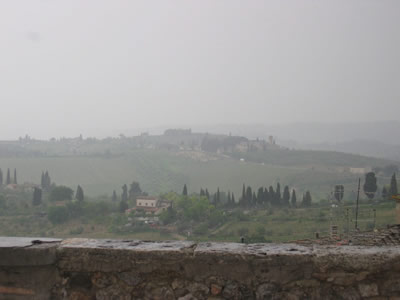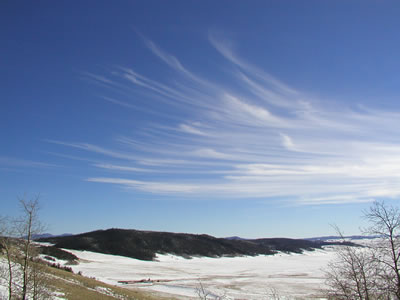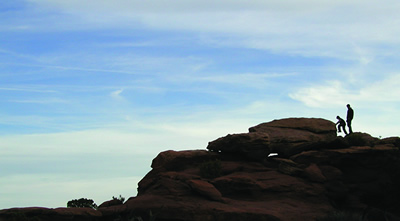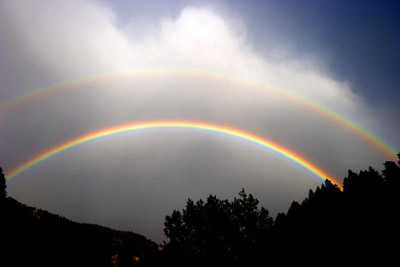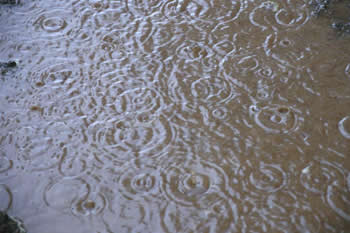A Photo Album of Atmospheric Optics Images |
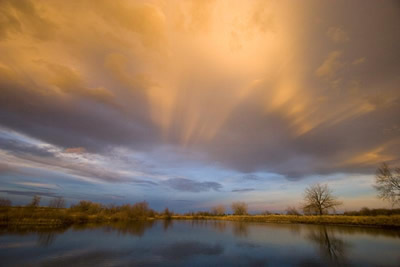 |
Anti-crepuscular Rays
Anti-crepuscular rays are beams of sunlight that appear to converge on a point opposite the sun. They are similar to crepuscular rays, but are seen opposite the sun in the sky. Anti-crepuscular rays are most frequently visible near sunrise or sunset. This photo of anti-crepuscular rays was taken at sunset in Boulder, Colorado. Crepuscular rays are usually much brighter than anti-crepuscular rays.
Image Courtesy of Carlye Calvin |
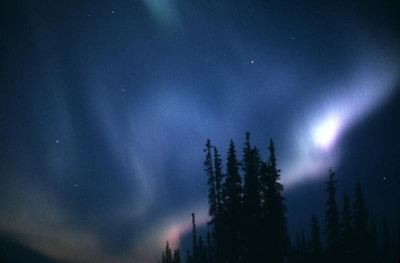 |
Aurora Borealis
Solar winds and other forms of solar activity are responsible for luminous streams of light known as the aurora borealis (northern lights), which appear in the sky mostly over polar latitudes. Charged particles streaming from the sun encounter gases in the Earth's upper atmosphere. These gases, mostly oxygen and nitrogen, are excited by the particles and, as a result, glow like a neon light.
Image Courtesy of University Corporation for Atmospheric Research |
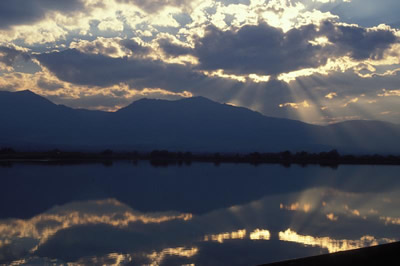 |
Crepuscular Rays
Crepuscular rays poking through clouds create a spectacular view as they diverge from the setting sun. Crepuscular rays are beams of light that appear to converge at a point and can be seen when the sun is partially blocked by clouds.
Image Courtesy of Carlye Calvin
|
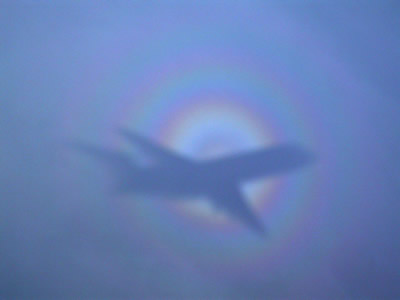 |
Glory
This photograph was taken from the window of an airplane. It is of a beautiful atmospheric phenomenon called the glory, shining in one direction directly opposite the sun. This circular bow is often seen on the tops of stratus clouds with relative uniformity and composed of water drops (not ice crystals). The shadow of the plane is the center, or in the case of mountain climbers, it is of the shadow of your head on top of mountains with clouds below and sunshine above.
Image Courtesy of Franz Kerschbaum, University of Vienna |
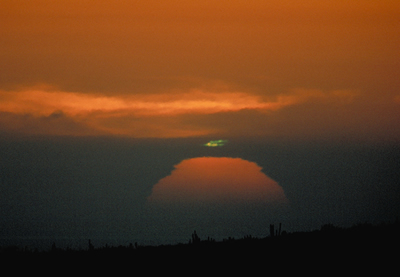 |
Green Flash
AA green flash can be seen at sunrise and sunset when part of the sun suddenly changes color, lasting for only a second or two. This image of a green flash was taken at sunset on April 30, 1995 near Cabo San Lucas, Mexico.
Image © 1995 Kenneth D. Langford |
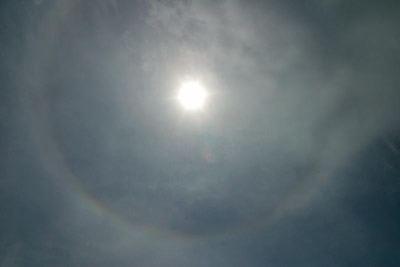 |
Ice Halos
Halos form when light from the sun or moon is refracted by ice crystals associated with thin, high-level clouds (like cirrus or cirrostratus clouds).
Image Courtesy of Carlye Calvin/University Corporation for Atmospheric Research |
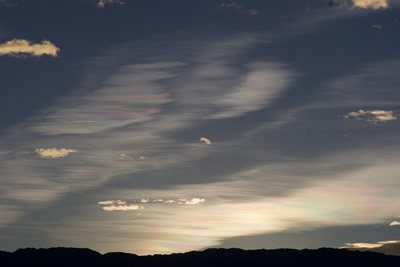 |
Iridescent Clouds
Patches of cloud occasionally develop iridescent (colored) borders. When sunlight or moonlight is diffracted as it passes through a cloud that contains water droplets or small ice crystals, faintly colored luminous rings of light known as coronas are formed. Iridescent borders of a cloud represent small portions of unusually large coronas. The color, which depends on the size of the droplets, ranges from bluish-white to brownish-red.
Image Courtesy of University Corporation for Atmospheric Research |
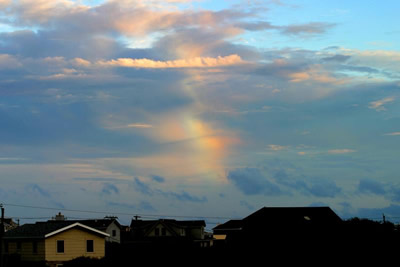 |
Perihelia
A perihelia (sun dog) is a bright patch or rainbow-like area that forms when sunlight passes through ice crystals in a cloud. They are typically seen when the Sun is low in the sky.
Image Courtesy of Carlye Calvin/University Corporation for Atmospheric Research |
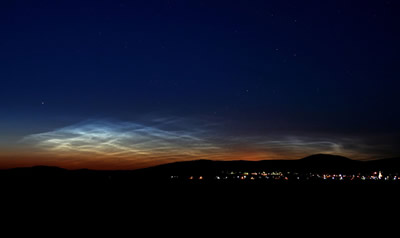 |
Polar Mesospheric Clouds (Noctilucent)
These mystifying clouds are called Polar Mesospheric Clouds, or PMCs, when they are viewed from space and referred to as "night-shining" clouds or Noctilucent Clouds, when viewed by observers on Earth. The clouds form in an upper layer of the Earth's atmosphere called the mesosphere during the summer and can be seen from the high latitudes on Earth.
Image Courtesy of NASA/Veres Viktor |
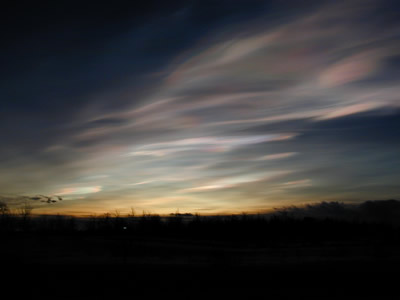 |
Polar Stratospheric Clouds (Nacreous)
This photograph shows Polar Stratospheric Clouds lit from below near Kiruna, Sweden. They form only at very low temperatures and help destroy ozone in the layer of the Earth's atmosphere called the stratosphere.
Image courtesy of NASA/Lamont Poole |
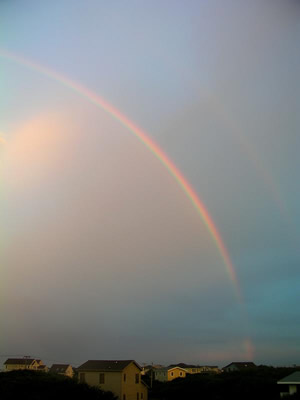 |
Rainbow
For a rainbow to form, water droplets must be present in the air in front of an observer and the sun must be shining from behind the observer. As sunlight enters a droplet, it is refracted (it slows and bends), with violet light bending the most and red light the least. Much of the light passes on through the drop, but some strikes the backside of the drop at such an angle that it is reflected back and is again refracted as it leaves the drop and passes to the observer's eyes. It takes myriads of droplets to produce the brilliant colors of a rainbow.
Image Courtesy of Carlye Calvin/University Corporation for Atmospheric Research |
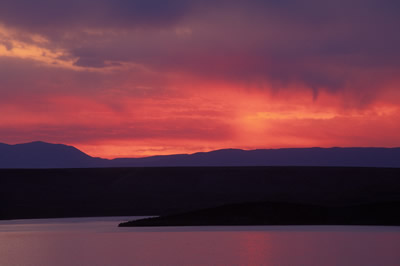 |
Rayleigh Scattering
At sunrise or sunset, the sky may appear red because blue light is scattered out as the sunlight passes almost horizontally through the atmosphere. This image of Rayleigh Scattering was taken at sunrise at Elephant Butte, New Mexico.
Image Courtesy of Carlye Calvin |
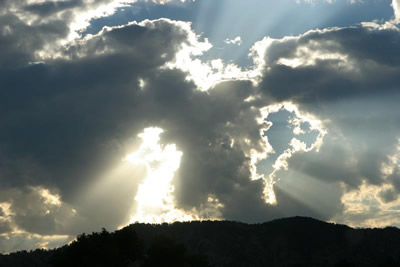 |
Silver Lining
A silver lining, which sometimes can be seen when the sun is behind a dark cloud, is the bright outline along the edge of the cloud. This effect occurs when the sunlight is diffracted by the cloud droplets around the edge of the cloud, and is the reason for the saying "every cloud has a silver lining." Crepuscular rays are also visible in this photograph.
Image Courtesy of Carlye Calvin |
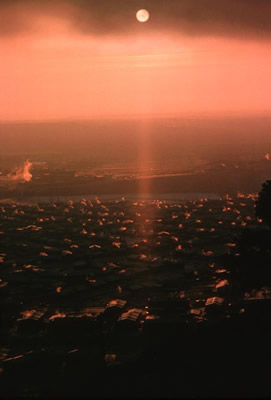 |
Sun Pillar
A sun pillar is a glittering vertical shaft of light, extending below and above the sun, most frequently observed at sunrise or sunset. It is caused by sunlight reflecting off ice crystals in the atmosphere. The crystals, commonly associated with cirrus clouds, tend to be hexagonal. They float in a horizontal orientation and their flat surfaces act like tiny mirrors, which is why the pillar follows a vertical line.
Image Courtesy of University Corporation for Atmospheric Research |














 Atmospheric Optics Image Gallery
Atmospheric Optics Image Gallery
 Learn More About Atmospheric Optics
Learn More About Atmospheric Optics






